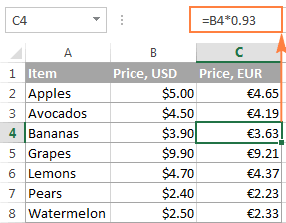

SummaryĪ dollar sign means that the part of the cell reference before which it has been used is anchored or fixed.īelow is a quick summary of what $ means in Excel formulas: Here is a good article that goes in-depth about the mixed cell references in Excel. This means that if you copy-paste the formula that uses C$3, the row would not change, but the column can change. This means that if you copy-paste the formula that uses $C3, the column would not change, but the row can change.Īnd when you add a dollar sign in front of the row number (3 in this example), it locks the column only. When you add a dollar sign in front of the column alphabet (C in this example), it locks the column only. In mixed cell references, you will have only one dollar sign (for example – $C3 or C$3) These are a little more complicated than the rest two. Instead, you can simply change the value in C3, and all the formulas would automatically update. While you can use the value itself, in the future, if you have to change the value in formulas, you will have to manually do it.
#Excel keyboard shortcut absolute cell reference code#
Note: If you’re wondering why not simply hard code the value instead of using the absolute cell reference (the one with two dollar signs). Note that this example has both, relative cell reference (without the $ sign) and an absolute cell reference (with two $ signs). This could be useful when you have some value that needs to remain constant (such as time period or interest rates, etc.)īelow is an example where I have a value in cell D2 which needs to remain constant (and not change when we copy-paste the formulas).īy using $D$2, we make sure that it doesn’t change when we copy-paste the cell with the formula. When you use this in formulas, it will not change the reference In absolute references, you have the $ sign before the row number and the column alphabet (example $C$3) Relative reference is where you don’t use a dollar ($) sign at all.Īnd when you copy a cell that has a relative reference, it will change and adjust based on the cell where you copy it.īelow is the same example again, where the references adjust as soon as we copy and paste the cell that has the formula. Let me quickly explain each of these with a simple example. In absolute reference, you use the dollar sign in twice in a reference (such as $C$3). In mixed references, you use the dollar sign ($) only once (such as $C3 or C$3) In relative references, you don’t use a dollar ($) sign in the references at all. There are three types of references in Excel:


When you use a $ sign before the cell reference (such as $C$2), you’re telling Excel to keep referring to cell C3 even when you copy and paste the formula. What if you want to copy the formula, but don’t want the cell reference to change? This is called relative reference where the references adjust based on the cell in which it has been applied.īut what if you don’t want some cells to adjust the reference? While in the formula in cell C2 refers to A2 and B2, the one in C3 refers to A3 and B3. You can see that the formula adjusts the references when I copy and paste it. One of the things that make Excel such a powerful tool is the ability to refer to cells/ranges and use these in formulas.Īnd when you copy these formulas, these cell references can adjust automatically (or should I say automatically).īelow is an example where I copy the cell C2 (which has a formula) and paste it in C3. Shortcut to add $ Sign to Cell References.


 0 kommentar(er)
0 kommentar(er)
